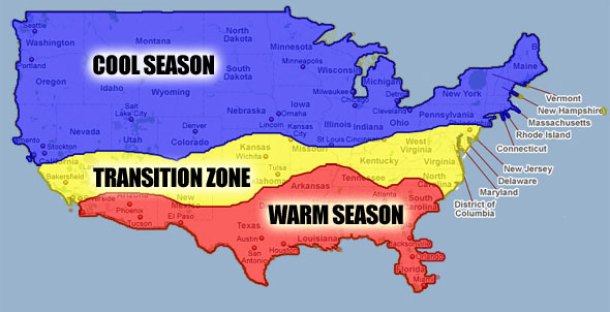Which Grass Type is Best for Your Lawn?
To assist with grass growth and selection, the USDA publishes a Lawn Grass Planting Climate Zone Map, which is a color-coded map based on climate and temperature. Common grasses are typically divided into two temperature categories based on the environment’s climate: cool season and warm season. Within the cool and warm-season zones, other climatic conditions can impact grass growth, such as humidity and aridity. The USDA further labels climate conditions as cool/humid, cool/arid, warm/humid and warm/arid.
Since many parts of the United States experience all four of those climate conditions, the USDA designates a “transition zone” where it is typically too cold in the winter for warm-season grasses, and too hot in the summer for cool-season grass types.
As the map below illustrates, the greater St. Louis area rests right on the edge of the transition zone and cool-season zone. Many St. Charles lawn care experts use a variety of species to better tolerate the local climate, however, Bluegrass is still the most common grass type used in new home construction due to cost.
For the best grass-growth results in the transition zone, use a tall fescue grass seed.

USDA Lawn Grass Planting Map
Curious about Scotts vs Pennington grass seeds? Check out our 3-week competition.
What are cool-season grasses?
Cool-season grasses see optimum growth at temperatures ranging from 60 – 75°F. Common cool-season grass species include Bentgrass, Kentucky Bluegrass, Red Fescue, Annual Ryegrass, Perennial Ryegrass, and Tall Fescue. Learn more about each species:
- Bentgrass: most commonly found at golf courses. One of the reasons this grass is so special is because it can tolerate heavy foot traffic and tolerate short cuttings. These characteristics make bentgrass an excellent type of turf for golf courses. It also has a strong dark green color. Bentgrass has shallow root systems making it easy to plant and grow.
- Kentucky Bluegrass: the best choice for a homeowner’s lawn. It is truly a “barefoot” grass at its finest. Bluegrass is one of the longest living perennial grasses. This grass can grow in a variety of places and can be found anywhere from Virginia to California. Kentucky bluegrass is often mixed with perennial ryegrass. Root growth of Kentucky bluegrass peaks at soil temperatures of 60°F and declines sharply as temperatures rise above 70°F. Root growth practically ceases at temperatures above 80°F.
- Red Fescue: a great choice if you live in a cool-season climate. This type of grass can be found mostly in cool, shaded, mountain sites, such as camps, resorts, and cabins where low-impact mowing, fertilization, and irrigation is desired. Its deep root system makes this grass resistant to drought and everyday wear and tear.
- Annual Ryegrass: great at protecting against erosion. Unlike most grasses, Annual Ryegrass requires minimal preparation for it to thrive. It is one of the few “throw-and-grow” grass types. This is not an aggressive type of grass and is a good choice to blend with any northern to warm-season grass for extra tolerance. This grass will remain unharmed with consistent mowing if you keep the blade height between 3’ to 4’ long.
- Perennial Ryegrass: a perfect choice for athletic fields that have lots of sun exposure. This type of grass is known for its toughness and quick growth while producing a shiny green look. Perennial Ryegrass is highly tolerant to diseases and insects.
- Tall Fescue:
What are warm-season grasses?
Warm-season grasses require temperatures between 80 – 95°F. Common warm-season grass species include:
- Bahia Grass: a subtropical to tropical type of forage grass that is most productive in loose sandy soils. It can tolerate salty conditions and is more disease and insect-friendly than other warm-season grasses.
- Bermuda Grass: has exceptional heat and drought tolerance. Its also called the “devil’s grass” because it is hard to get rid of. Bermudagrass is reported to have serum glucose-lowering and antidiabetic effects, antimicrobial and antiviral properties, and has been suggested for the treatment of urinary tract infections, prostatitis, syphilis, and dysentery.
- Carpet Grass: will grow well in sandy conditions and does well in Missouri. Because it requires little maintenance it is commonly used in parks, roadsides, airports and golf course roughs. It tolerates areas that are too wet for Bermudagrass.
- Centipede Grass: does well in sandy soils with limited nutrients and can usually be found in the southern US. It has a longer growth cycle but requires little fertilization. Too much iron can cause blades to turn yellow so your lawn may require iron supplements to combat this. It is drought tolerant and when healthy can choke out all other weeds.
- St. Augustine Grass: thrives in hot and humid conditions. St. Augustine grasses are most popular in pastures and ranches. They are also popular grass covers for home lawns. It can grow in any pH levels from 5.0 to 8.5. Only recently has a seed been developed for this grass it has been spread by plugs, sprigs, or sod.
- Zoysia Grass: grows best in a climate over 80 degrees. It has shallow root systems and is drought tolerant. It can be a great type of grass for a homeowner. It is a slow-growing grass and will take over a lawn over time.
What are transition-zone grasses?
A common practice for lawn care experts who operate in the transition zone is to grow a combination of grass types based on the season. Warm-season grass seed is used when temperatures favor them, then a cool-season seed is used to overseed the warm-season grass as the seasons change.
The best grass types for the transition zone are Tall Fescue, Kentucky Bluegrass, Perennial Ryegrass, or Zoysia grass.
Seeding and maintaining a beautiful lawn is no simple feat, especially in the transition zone where climate extremes are common. Let Greenside Lawn Care take care of the guesswork – call today for a free estimate.
Learn more about our other services in St. Charles, MO: